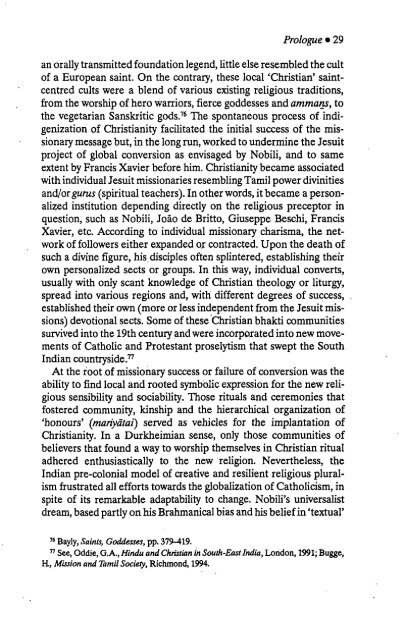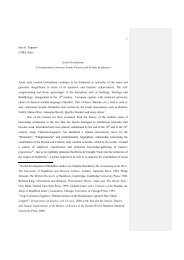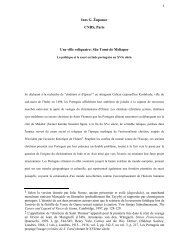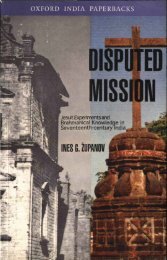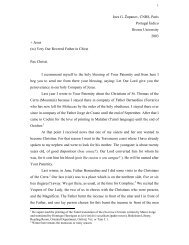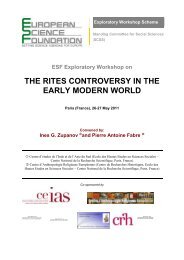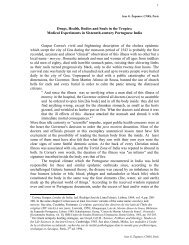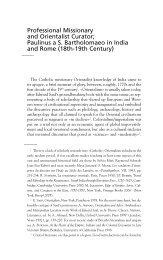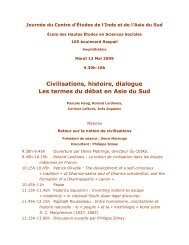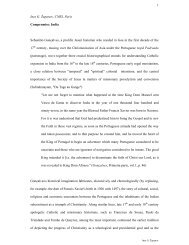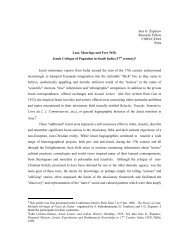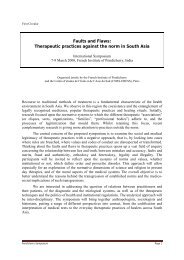INES G. ZUPANOV - Ines G. Županov
INES G. ZUPANOV - Ines G. Županov
INES G. ZUPANOV - Ines G. Županov
You also want an ePaper? Increase the reach of your titles
YUMPU automatically turns print PDFs into web optimized ePapers that Google loves.
Prologue • 29<br />
an orally transmitted foundation legend, little else resembled the cult<br />
of a European saint. On the contrary, these local 'Christian' saintcentred<br />
cults were a blend of various existing religious traditions,<br />
from the worship of hero warriors, fierce goddesses and ammans, to<br />
the vegetarian Sanskritic gods. 76 The spontaneous process of indigenization<br />
of Christianity facilitated the initial success of the missionary<br />
message but, in the long run, worked to undermine the Jesuit<br />
project of global conversion as envisaged by Nobili, and to same<br />
extent by Francis Xavier before him. Christianity became associated<br />
with individual Jesuit missionaries resembling Tamil power divinities<br />
and/or gurus (spiritual teachers). In other words, it became a personalized<br />
institution depending directly on the religious preceptor in<br />
question, such as Nobili, Joäo de Britto, Giuseppe Beschi, Francis<br />
Xavier, etc. According to individual missionary charisma, the network<br />
of followers either expanded or contracted. Upon the death of<br />
such a divine figure, his disciples often splintered, establishing their<br />
own personalized sects or groups. In this way, individual converts,<br />
usually with only scant knowledge of Christian theology or liturgy,<br />
spread into various regions and, with different degrees of success,<br />
established their own (more or less independent from the Jesuit missions)<br />
devotional sects. Some of these Christian bhakti communities<br />
survived into the 19th century and were incorporated into new movements<br />
of Catholic and Protestant proselytism that swept the South<br />
Indian countryside. 77<br />
At the root of missionary success or failure of conversion was the<br />
ability to find local and rooted symbolic expression for the new religious<br />
sensibility and sociability. Those rituals and ceremonies that<br />
fostered community, kinship and the hierarchical organization of<br />
'honours' (mariyätai) served as vehicles for the implantation of<br />
Christianity. In a Durkheimian sense, only those communities of<br />
believers that found a way to worship themselves in Christian ritual<br />
adhered enthusiastically to the new religion. Nevertheless, the<br />
Indian pre-colonial model of creative and resilient religious pluralism<br />
frustrated all efforts towards the globalization of Catholicism, in<br />
spite of its remarkable adaptability to change. Nobili's universalist<br />
dream, based partly on his Brahmanical bias and his belief in 'textual'<br />
76 Bayly, Saints, Goddesses, pp. 379-419.<br />
77 See, Oddie, G.A., Hindu and Christian in South-East India, London, 1991; Bugge,<br />
H., Mission and Tamil Society, Richmond, 1994.


